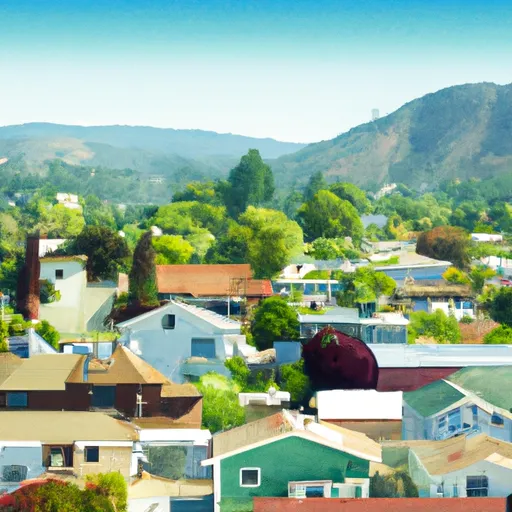-
 Snoflo Premium
Snoflo Premium
Get unlimited access to all our content
With no Ad interruptions! - Start Your Free Trial Login with existing account
West-Point
Eden Index
Climate
9.5
•
Recreation
5.1
•
Community
•
Safeguard
5.6/10

West Point, California is a small rural town located in the central Sierra Nevada foothills. The climate in this area is characterized by hot, dry summers and mild, wet winters. Summers often see temperatures soaring into the 90s, while winters are relatively cool with temperatures ranging from the 30s to 50s. The region experiences a Mediterranean climate, with most precipitation occurring between November and April.
Hydrology constituents in West Point are primarily influenced by the Mokelumne River, which flows nearby. This river provides a vital water source for the community and supports a diverse range of wildlife. The area is also home to several creeks and streams that contribute to the local hydrology.
Outdoor recreation opportunities abound in West Point and its surrounding areas. The region offers numerous hiking trails, including the popular Mokelumne Coast to Crest Trail that winds through scenic landscapes. Fishing enthusiasts can enjoy casting their lines in the Mokelumne River, known for its abundance of trout. For those seeking a more adventurous experience, there are opportunities for whitewater rafting and kayaking. With its picturesque surroundings and diverse recreational options, West Point is an ideal destination for nature lovers and outdoor enthusiasts.
What is the Eden Index?
The Snoflo Eden Index serves as a comprehensive rating system for regions, evaluating their desirability through a holistic assessment of climate health, outdoor recreation opportunities, and natural disaster risk, acknowledging the profound impact of these factors on livability and well-being.
Climate Health Indicator (CHI): 9.5
West-Point receives approximately
1270mm of rain per year,
with humidity levels near 75%
and air temperatures averaging around
14°C.
West-Point has a plant hardyness factor of
9, meaning
plants and agriculture in this region tend to thrive here all year round.
By considering the ideal temperature range, reliable water supplies, clean air, and stable seasonal rain or snowpacks, the Climate Health Indicator (CHI) underscores the significance of a healthy climate as the foundation for quality living.
A healthy climate is paramount for ensuring a high quality of life and livability in a region, fostering both physical well-being and environmental harmony. This can be characterized by ideal temperatures, reliable access to water supplies, clean air, and consistent seasonal rain or snowpacks.
Weather Forecast
Streamflow Conditions
San Joaquin
Area Rivers
San Joaquin
Snowpack Depths
San Joaquin
Reservoir Storage Capacity
San Joaquin
Groundwater Levels
Recreational Opportunity Index (ROI): 5.1
The Recreational Opportunity Index (ROI) recognizes the value of outdoor recreational options, such as parks, hiking trails, camping sites, and fishing spots, while acknowledging that climate plays a pivotal role in ensuring the comfort and consistency of these experiences.
Access to outdoor recreational opportunities, encompassing activities such as parks, hiking, camping, and fishing, is crucial for overall well-being, and the climate plays a pivotal role in enabling and enhancing these experiences, ensuring that individuals can engage in nature-based activities comfortably and consistently.
Camping Areas
| Campground | Campsites | Reservations | Toilets | Showers | Elevation |
|---|---|---|---|---|---|
| Pine Cone - Sly Park Recreation Area | None | 3,488 ft | |||
| Strawberry Point | 10 | 5,440 ft | |||
| Hazel Creek - Sly Park Recreation Area | None | 3,548 ft | |||
| China Flat | 19 | 4,790 ft | |||
| Northwind | 9 | 5,477 ft | |||
| Ice House | 83 | 5,493 ft | |||
| Rainbow - Sly Park Recreation Area | None | 3,579 ft | |||
| Deerwood - Sly Park Recreation Area | None | 3,622 ft | |||
| Sly Park | 191 | 3,596 ft | |||
| Kane XXX - Sly Park Recreation Area | None | 3,588 ft |
Nearby Fishing
Nearby Ski Areas
Catastrophe Safeguard Index (CSI):
The Catastrophe Safeguard Index (CSI) recognizes that natural disaster risk, encompassing floods, fires, hurricanes, and tornadoes, can drastically affect safety and the overall appeal of an area.
The level of natural disaster risk in a region significantly affects safety and the overall livability, with climate change amplifying these risks by potentially increasing the frequency and intensity of events like floods, fires, hurricanes, and tornadoes, thereby posing substantial challenges to community resilience and well-being.
Community Resilience Indicator (CRI):
The Community Resilience Indicator (CRI) recognizes that education, healthcare, and socioeconomics are crucial to the well-being of a region. The CRI acknowledges the profound impact of these elements on residents' overall quality of life. By evaluating educational resources, healthcare accessibility, and economic inclusivity, the index captures the essential aspects that contribute to a thriving community, fostering resident satisfaction, equity, and social cohesion.

